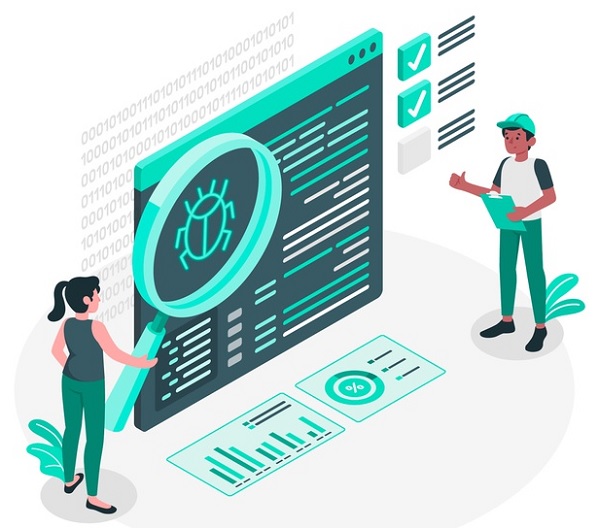
As the web applications are becoming more crucial for online survival, the industries are leveraging more and more of them. Whether the retail sector, or the transp[ortation and supply chain, every industry today is actively utilizing robust and scalable custom software solutions and mobile applications to fulfill their business needs.
Custom software applications, besides providing freedom on choosing features and development tools, even allows the developers to include any security tools they want. That helps the businesses not only to save a great money but even ensures proper and safe business with custom security tools as per the needs of the project.
As per a study, the custom software applications that you create can be a major part of your competitive edge over other marketers of the same niche.
Now, although custom web applications are of so much importance for your business, its standards have changed significantly. Yes, you heard it right! The custom web application scenario has evolved a lot in the past few years, yet many of the marketers are still struggling to adapt the modern web development techniques. As a result, their application fails to deliver the right kind of results and that hampers their brand value!
So, to ensure that your organization never faces any such circumstances, here are the top seven do’s and don’ts that you should be following while developing a custom application. Let’s dive in!
1. Target Audience

Do’s : Build for Multi-Platform Users
The present digital mera is all about mobile and tablets. In such a mobile world, nobody has enough time to sit on a desktop or laptop and perform any vital tasks. Even important business operations today are getting mobile after witnessing the current pandemic situation.
That’s why you must ensure to make a fully responsive application as per your target audience. You should also work on making your custom solution user-friendly so that users could seamlessly shift from one device to another without any compromise in interface and functionalities.
Don’ts : Build only for PC Users
Despite the fact that most of the traffic today is generated by mobile apps, many marketers and developers still built custom software solutions solely for desktop users. As a result, their custom applications might be very useful for the core business processes., but they do not remain feasible for the rest of the global users.
So, you must ensure to build fully responsive web applications that can work smoothly on every platform whether laptop or mobile or even tablets.
Read More: Discover how custom web application development empowers businesses with tailored solutions for seamless operations and enhanced digital growth.
2. Customizations
Do’s : Keep User-Centric Approach
Your customers and users are the most crucial aspect for your business. And the importance even increases after witnessing the huge competition in today’s digital world. That;’s why it is always advisable to plan your designs and features as per your user needs. Think of all the features and design aspects that can make the people a constant user of your application.
Furthermore, even if any design is very intriguing and amazing, it is always better to go with a simple yet aesthetic design that can make the usage of application much easier for your target audience.
Don’ts : Create for Yourself
It is very easy to create something for yourself. You don’t have to think about what others will like or how others will deal with it. Similar is the case when you design or develop any application keeping yourself in mind while ignoring your user perception. Think of it like this, suppose you are a User Interfacedesigner and you chose a design that is highly amazing but is very complicated.
Meaning, it is not helping the users in getting versed with the application. That is when your app will fail and it will be a total waste of time and money as people will eventually leave your application forever. Hence, even if you are creating an enterprise application, you have to think of them as general users who are completely new to the platform and then should fix the design and development tools.
3. Design and Development

Do’s : Remain open for Customizations
As stated earlier, it is always a wise decision to treat your audience as general users and design the platform as per their convenience. However, in today’s digital world every is temporary but change is permanent. That’s why, you should always be ready to customize the features and the design aspects to satisfy the customer needs and growing market trends.
But, it is also advisable to not include any of the changes that you think might impact the performance and underlying goals of the application. The best way to do that is to communicate with the client and try to incorporate your views on the development process.
Don’ts : Ignore the Basic Underlying Aim
While customizations and change is very much needed to satisfy the ever-changing consumer needs, one should also not forget about the underlying development principles. Meaning, you should always work in such a manner, that the basic business goals on which the whole application is building remains secure and alive. Spend valuable time in coding and less time in making changes that may not be much valuable after a few times.
4. Technology Stack
Do’s : Use Reliable Technology and Development Tools
Now, we are not saying that you should never experiment with any new and advanced technology. However, in today’s digital world, everything is changing constantly, and so are the technology aspects. That’s why even a slightest mistake in choosing the wrong technology could cost you more.
Hence, you should always include reliable and proven technology tools and languages that according to market will have long-term existence. For instance, just a few years back, people actively leveraged R language for data analytics systems. However, the growth of Python consumed every bit of R and soon that language became an outdated version in the field of data sciences.
Don’ts : Go for the ‘Latest’ and ‘Greatest’
The world today is going mobile. That’s why every bit of the technology is changing rapidly. Each day a new technology is gaining heights and some existing technology is falling to a great depth. That’s why it is always advisable to never go for any new technology that does not have any proven grounds of existence.
Now, you may initially feel very amazing because of the simple and amazing functionalities of the new language, but as soon as it’s hype will finish, the custom software built over that particular technology or language will be of no use. You will either have to build it from scratch or need to hire any developer that will constantly update the software. In both the scenarios you will have to bear a lot of expenses.
5. QA Testing

Do’s : Include Automated Testing
Now, thanks to the digital world we live in, today we have instant access to any new and advanced testing technology that could help in making our software error-free. Automated testing is one such feature that has made the QA testing a piece of cake for the testers.
With automated testing, the testers need not invest much time, and they will get all the major and even the minutest of the bugs in no time. Plus, they would also get any device support errors that would otherwise need much time of the testers.
Read more: Everything You Need to Know About Automation Testing
Don’ts : Be Negligent
In order to deploy the custom software quickly. One should never avoid the testing process. Testing is the most crucial part for any custom software application as it detects the bugs that were unnoticeable during the development process.
Even security issues, and form functionality errors could leave a major impact on the overall performance of the custom software solutions. That’s why testers should always be alerted during the QA process. Also, ensure that app is built as per industry standards and regulator compliances of the state in which it is being launched.
6. Data Security
Do’s : Encrypt any Sensitive User Database
Security has always been a sensitive issue even after so many years of digitization. Hence, as an experienced software engineering firm, we always advise our developers and users to secure their data with encryption and authentication models.
Using encrypted tools and multi-factor authentication helps to eliminate any unwanted access to our secure information. Plus, we even include advanced security and tracking tools in our custom software solutions to let the admin know who all accessed what all information and whether any change was made by them or not. That further helps to exactly determine at what stage any information has been changed and by whom.
Don’ts : Store Sensitive Information as Plain Text
Storing sensitive information as plain text is the greatest don’t while framing any custom software application. With the rise in digitization, the cyber thefts and online frauds increased to a significant extent. Today, if your information is present without any security and as plain text, then hackers will access them in no time. Results?
Large bank frauds, leakage of sensitive business information, and negative impact on brand value that may result in monetary losses and loss of users. Hence, always try to use encryption models and two-factor authentication. You can even leverage cloud-based services to store all your information over a remote server and at a centralized position.
7. Communication

Do’s : Communicate Actively
Last but not least, communication is the key to a better product development. If you fail to convey any message from your side to your customers on time, then it may not only impact your product development, but can also bring negative reviews on your brand name.
On the other hand, if your customer does not timely convey any sort of inputs to you, then the product may not be built as per his/her expectations and that will eventually increase the cost and development time. Hence, invest in good and active communication systems so that the messages from both the sides could be conveyed on time and to the exact person.
Don’ts : Allow Misunderstandings
Lastly, always try to bridge the gap between the user and the developers, or between developers and testers, or even between the testers and the client managers. Communication gaps often lead to misunderstanding, and that eventually creates a wrong p[erception of information and incorrect software development.
So, to prevent any time or cost losses, and to effectively deliver the right product to the right person and at the right time, invest in good communication channels. Moreover, try to take daily or at least weekly meetings with the project team, and include as much input as you could from the customer.
Over to you!
Now that you all are aware of the common mistakes you have been doing, it is time to rectify those errors. How? Invest in an experienced software engineering firm like Matellio that provides sufficient support and undertakes agile development process.
We, at Matellio, have years of experience in delivering best-in-class custom software solutions and mobile applications that perfectly fits the user’s needs. Our expert programmers and testers promise to deliver error-free and flexible custom software at a minimal possible price. Have more questions? Reach us today, and get a free expert consultation on your first visit!
Till then, Happy Development!



